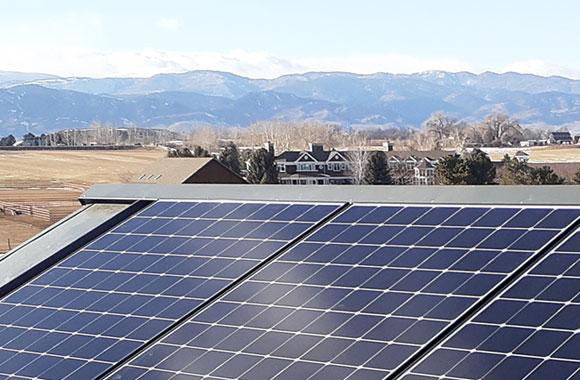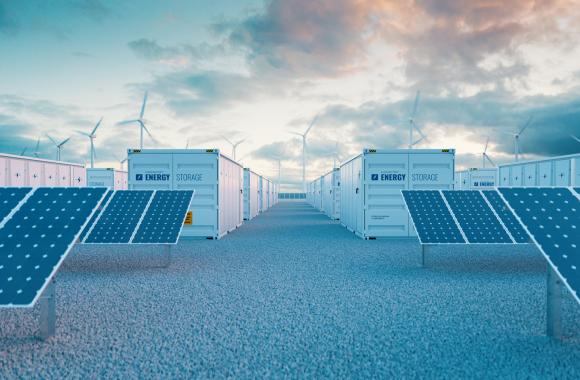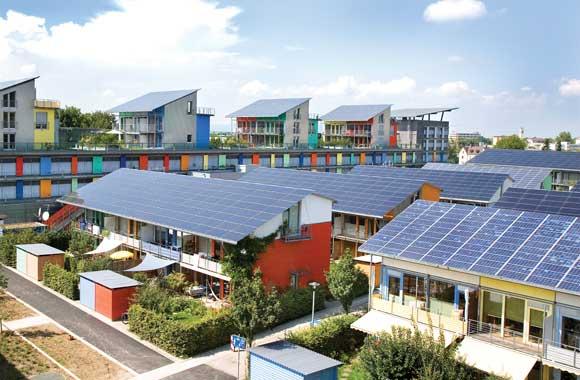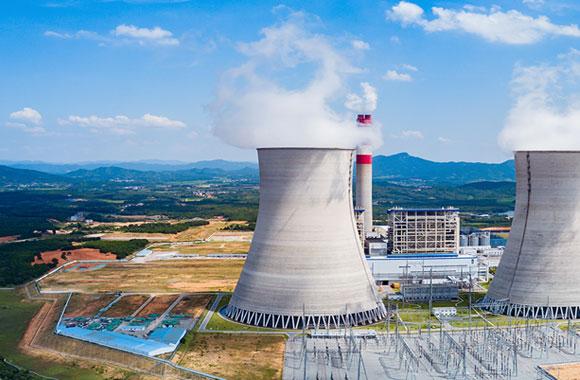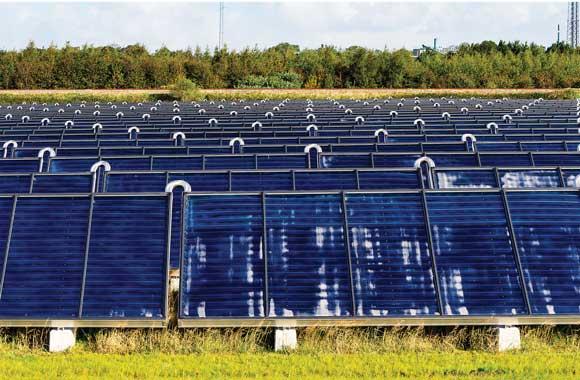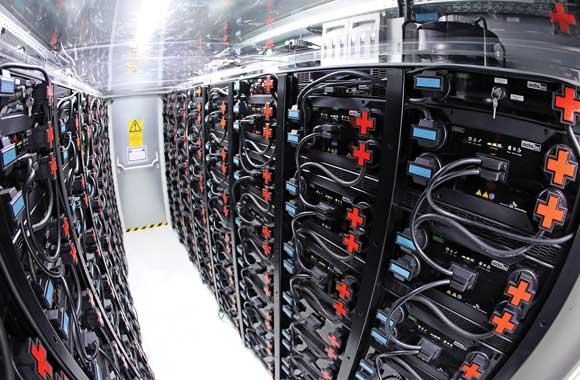Utility-Scale Solar Photovoltaics
Solar photovoltaics can be used at utility-scale—with hundreds or thousands of panels—to replace fossil-fuel electricity generation.
Reduced/Sequestered
2020–2050
To Implement
Operational Savings
Impact
Just over 3 percent of global electricity generation is estimated to be from utility-scale solar photovoltaics (PV). Our scenarios project that by 2050, utility-scale PV could generate 21–25 percent of electricity, some 9,015.58–17,117.72 terawatt-hours. We assume an implementation cost of $1,733 per kilowatt and a learning rate of 21 percent. This results in cumulative first benefit of US$0.22–1.34 trillion, with a lifetime net operational savings of US$12.52–25.56 trillion. This could avoid 40.83–111.59 gigatons of greenhouse gas emissions.
Introduction
The sun provides a virtually unlimited, clean, and free energy source. Utility-scale solar photovoltaics (PVs) take advantage of that resource, using large arrays of PV panels to capture that energy and transform it to electricity. They operate at a utility scale like conventional power plants, but have dramatically lower greenhouse gas emissions.
Project Drawdown’s Utility-Scale Solar Photovoltaics solution focuses on the use of solar PV systems bigger than 10 megawatts to generate electricity. This solution replaces conventional electricity-generating technologies such as coal, oil, and natural gas power plants.
The photovoltaic market has grown tremendously since 2010. At least 480 gigawatts of total solar PV capacity were installed worldwide by the end of 2018 (IRENA, 2019). In many markets, the newly installed capacity is coming primarily from utility-scale installations rather than from distributed systems. Some recent scenarios have predicted almost 60 percent of global electricity generation to come from solar energy by 2050.
Methodology
To capture the appropriate level of agency, we split the solar PV market between our Distributed Solar Photovoltaics solution (representing households and building owners) and this Utility-Scale Solar Photovoltaics solution.
Total Addressable Market
We based the total addressable market for the Utility-Scale Solar Photovoltaics solution on projected global electricity generation from 2020 to 2050. The total addressable market is different for our two adoption scenarios because Scenario 2 projects extensive electrification of transportation, space heating, etc., dramatically increasing demand and therefore production of electricity worldwide.
We estimated current adoption (the amount of functional demand supplied in 2018) at 1.04 percent (274 terawatt-hours) of generation. With no definitive estimation of the type of future solar PV adoption, we assume that distributed PV installations represent around 40 percent of the market, with utility-scale solar capturing the remaining 60 percent (US DOE, 2012; IEA, 2014; SEIA, 2015).
Adoption Scenarios
We calculated impacts of increased adoption of utility scale solar photovoltaics from 2020 to 2050 by comparing two scenarios with a reference scenario in which the market share was fixed at current levels.
- Scenario 1: This scenario is based on the evaluation of adoption trajectories of five ambitious adoption scenarios: IEA (2017) Energy Technology Perspectives 2DS and B2DS scenarios; IEA (2018) World Energy Outlook SDS; IRENA (2019) REmap Case scenario; and Grantham Institute and Carbon Tracker (2017) Strong PV Scenario, using a high growth trajectory. By 2050, 9,015.58 terawatt-hours are installed (21 percent of the total addressable market).
- Scenario 2: This scenario is derived from three 100 percent RES scenarios of electricity generation by 2050: Greenpeace (2015) Advanced Energy [R]evolution Scenario; Ram et al. (2019) scenario; and Ecofys (2018) 1.5°C scenario. These scenarios represent a very ambitious pathway towards a fully decarbonized energy system in 2050. By 2050, 17,117.72 terawatt hours are installed (25 percent of the total addressable market).
Financial Model
All monetary values are presented in 2014 US$.
Based on a meta-analysis of data collected for systems installation costs around the world, we assumed a total first cost of US$1,734 per kilowatt. We developed a learning rate of 21.0 percent, accounting for independent impact on PV modules and balance of systems; this has the effect of reducing the installation cost to US$490 per kilowatt in 2030 and US$336 in 2050, compared with US$1,786 per kilowatt for the conventional technologies. We used an average capacity factor of 21 percent for the solution, compared with 57 percent for conventional technologies. Fixed operation and maintenance costs considered for utility scale photovoltaics are US$15.94 per kilowatt, compared with US$34.7 per kilowatt for the conventional technologies.
Integration
We adjusted the total addressable markets to account for reduced demand resulting from the growth of more energy-efficient solutions (e.g., LED Lighting and High-Efficiency Heat Pumps) as well as increased electrification from other solutions such as Electric Cars and High-Speed Rail. We calculated grid emissions factors based on the annual mix of different electricity-generating technologies over time. We determined emissions factors for each technology through a meta-analysis of multiple sources, covering both direct and indirect emissions.
Results
Scenario 1 avoids 40.83 gigatons of carbon dioxide equivalent greenhouse gas emissions with US$0.22 trillion in net first benefits. We project US$12.52 trillion of lifetime operational savings, principally because utility-scale PV does not require fuel.
Scenario 2 offered reductions of 111.59 gigatons of carbon dioxide equivalent emissions with US$1.34 trillion in net first benefits and US$25.56 trillion in lifetime operational savings.
Discussion
Solar PV has seen unprecedented levels of growth around the world since 2005, due primarily to advancements in technology and declines in costs. Only modest advancements in production are needed before utility-scale systems are cost-competitive with fossil fuel generation around the world. As a result, utility-scale PV is likely to continue its rapid growth in many regional markets and will play an increasingly important role in future global electricity supply, regardless of climate mitigation goals. If utilities and project developers, spurred by local and national governments, accelerate the adoption of utility-scale solar over the next 30 years, the world will reap major benefits in terms of greenhouse gas emissions reduction.
Solar has an incredibly promising long-term potential because sunlight is plentiful and widespread. Future advances in both battery and PV technologies should continue to drive the adoption of this technology, even without policy interventions. The financial benefits of rapid utility-scale PV adoption will also be considerable, and these can help jump-start adoption. There are significant investment costs associated with accelerated adoption, but this is an opportunity to generate wealth and economic growth because the return on investment is also substantial.
The accelerated installation of new utility-scale PV capacity will not be without challenges, however, as traditional electricity markets and grids are in many cases not primed for a high penetration of intermittent, renewable energy. There will be economic, policy, and social hurdles to overcome on the pathway set out in our scenarios, and some of these will require significant changes to the way we buy, sell, and even use electricity. But given the immense climate and financial impacts of global utility-scale PV adoption, it is imperative that we take on these challenges.
References
Ecofys (2018). Energy transition within 1.5ºC. A disruptive approach to 100% decarbonization of the global energy system by 2050. https://www.navigant.com/-/media/www/site/downloads/energy/2018/navigant2018energytransitionwithin15c.pdf
Grantham Institute and Carbon Tracker (2017). Expect the Unexpected: The Disruptive Power of Low-carbon Technology. https://www.carbontracker.org/reports/expect-the-unexpected-the-disruptive-power-of-low-carbon-technology/
Greenpeace. (2015). World Energy [R]evolution, a sustainable world energy outlook. Retrieved from http://www.greenpeace.org/international/Global/international/publications/climate/2015/Energy-Revolution-2015-Full.pdf
IEA. (2014). Projected Costs of Generating Electricity – edition 2010. Organisation for Economic Co-operation and Development - International Energy Agency and Nuclear Energy Agency. France. Retrieved from http://www.worldenergyoutlook.org/media/weowebsite/energymodel.
International Energy Agency (IEA). (2017). Energy Technology Perspectives 2017 : Catalysing energy technology transformations. International Energy Agency. https://www.iea.org/etp2017/
International Energy Agency (IEA). (2018). World Energy Outlook 2018. https://iea.blob.core.windows.net/assets/77ecf96c-5f4b-4d0d-9d93-d81b938217cb/World_Energy_Outlook_2018.pdf
International Renewable Energy Agency (IRENA). (2019). Global energy transformation: The REmap transition pathway Ed. 2019. https://www.irena.org/publications/2019/Apr/Global-energy-transformation-The-REmap-transition-pathway
Ram M., Bogdanov D., Aghahosseini A., Gulagi A., Oyewo A.S., Child M., Caldera U., Sadovskaia K., Farfan J., Barbosa LSNS., Fasihi M., Khalili S., Dalheimer B.,Gruber G., Traber T., De Caluwe F., Fell H.-J., Breyer C.(2019). Global Energy System based on 100% Renewable Energy –Power, Heat, Transport and Desalination Sectors. Study by Lappeenranta University of Technology and Energy Watch Group, Lappeenranta, Berlin, March 2019. Retrieved from: http://energywatchgroup.org/wp-content/uploads/EWG_LUT_100RE_All_Sectors_Global_Report_2019.pdf
Solar Energy Industries Association (SEIA). (2015). Solar Market Insight Report 2014 Q4. http://www.seia.org/research-resources/solar-market-insight-report-2014-q4
What You Can Do
Help your public utilities commission to consider solar PV as an alternative to fossil fuels.
Encourage your workplace to help meet its electricity needs with photovoltaics by supporting a solar garden or farm.
- Expand your knowledge by exploring another Drawdown solution.







